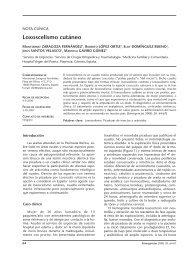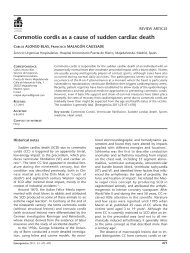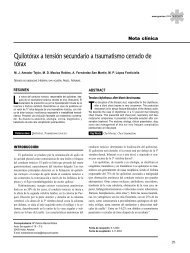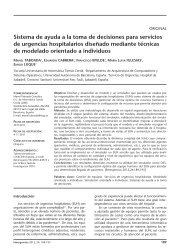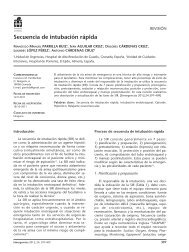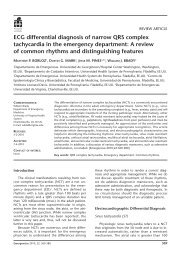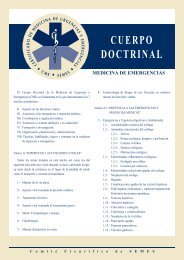Traumatic Intercostal Pulmonary Hernia - Semes
Traumatic Intercostal Pulmonary Hernia - Semes
Traumatic Intercostal Pulmonary Hernia - Semes
You also want an ePaper? Increase the reach of your titles
YUMPU automatically turns print PDFs into web optimized ePapers that Google loves.
LETTERS TO THE EDITOR<br />
Lung hernia is a rare entity, with approximately<br />
300 cases reported in the literature 4 . According to<br />
Morel-Lavelle, it may be divided into congenital<br />
and acquired; the latter in turn may be pathological,<br />
traumatic or spontaneous. Spontaneous hernias<br />
are associated with manoeuvres involving extreme<br />
pressure on the chest wall (such as<br />
coughing or sneezing) causing the fracture of one<br />
or more ribs or intercostal muscle tear. Generally,<br />
this presents in patients with senile osteoporosis<br />
and / or chronic coughs. Protrusion of the lung<br />
wall may occur through the intercostal spaces<br />
(65% of cases), supraclavicular region (35% of cases)<br />
6 or through diaphragmatic wall defects (rare).<br />
<strong>Traumatic</strong> lung hernia, such as in our case, is<br />
rare and mostly due to high-energy, blunt chest<br />
trauma 5 . It does not necessarily present immediately<br />
after the impact, and may appear months or<br />
even years later 1,7 . The etiology may be explained<br />
by the anatomy of the intercostal spaces. The external<br />
and internal intercostal muscles that line<br />
the internal intercostal space are somewhat shorter<br />
than the ribs, so that one end of the space is<br />
covered by only one of the muscles and the other<br />
by aponeurosis (sinew). <strong>Intercostal</strong> spaces also have<br />
perforations through which chest wall vessels<br />
and nerves pass. Precisely these places are the<br />
most fragile parts of intercostal spaces, and the<br />
most susceptible to high pressure manoeuvres.<br />
They do not represent a serious problem unless<br />
incarceration and / or strangulation occurs,<br />
which cause pain and sometimes haemoptysis 8 .<br />
Besides good clinical examination, diagnosis<br />
usually requires chest X-ray, with oblique projections<br />
being most useful 9 . However, the diagnostic<br />
tool of choice is chest CT scan since it allows visualization<br />
of the pneumocele, its exact location<br />
and the size of the chest wall defect 10,11 .<br />
With regard to therapeutic approach, there is<br />
sharp controversy 12 . Some authors prefer a conservative<br />
approach with immobilizing bandage, and<br />
if this fails and / or complications arise, then opt<br />
for surgical repair. However, others claim that surgery<br />
is indicated in all anterior intercostal hernias,<br />
even if they are asymptomatic, by means of surgical<br />
repair or prosthetic (PTFE) patch repair with<br />
open surgery or thoracoscopy.<br />
References<br />
1 Taylor DA, Jacobson HG. Post-traumatic herniation of the lng. Radiology.<br />
1962;5:896-9.<br />
2 Morel-Lavelle A. <strong>Hernia</strong>s du Pomon. Bull Soc Chir Paris. 1847;1:75.<br />
3 Moncada R, Vade A, Gimenez C, Rosado W, Demos TC, Turbin R.<br />
Congenital and acquired lung hernias. J Torac Imaging. 1996;11:75-<br />
82.<br />
4 Reardon MJ, Fabre J, Reardon PR, Baldwin JC. Video-assisted repair of<br />
a traumatic intercostals pulmonary hernia. Ann Thorac Surg.<br />
1998;65:1155-7.<br />
5 Jiménez Aguero R, Hernández Ortiz C, Izquierdo Elea JM, Cabeza<br />
Sánchez R. <strong>Hernia</strong> pulmonar intercostal espontánea: aportación de<br />
un caso. Arch Bronconeumol. 2000;36:354-6.<br />
6 Munnell ER. <strong>Hernia</strong>tion of the lung. Ann Thorac Surg.<br />
1968;5(Supl):204.<br />
7 Reynolds, J, Davis JT. Injuries of the chest wall, pleura, pericardium,<br />
lung bronchi and esophagus. Radiol Clin North Am. 1966;4:383-<br />
401.<br />
8 Francois B, Desachy A, Cornu E, Ostyn E, Niquet L, Vignon P. <strong>Traumatic</strong><br />
pulmonary hernia: surgical versus conservative management. J<br />
Trauma. 1998;44:217-9.<br />
9 Allen GS, Fischer RP. <strong>Traumatic</strong> lung herniation. Ann Thorac Surg.<br />
1997;63:1455-6.<br />
10 Hauser M, Weder W, Largiader F, Glazer GM. Lung herniation<br />
through a postthoracoscopy chest wall defect: demostratio with spiral<br />
CT. Chest. 1997;112:558-60.<br />
11 Tamburro F, Grassi R, Romano R, Del Vecchio W. Adquired spontaneus<br />
intercostal hernia of the lung diagnosed on helical CT. Am J Roentgenol.<br />
2000;174:876-7.<br />
12 Goverde P, Van ZIL P, Van der Brande F, Vanmaele R. Chronic of the<br />
lung in patint with chronic obstructive pulmonary disease. Case report<br />
and review of the literature. Thorac Cardiovasc Surg.<br />
1988;46:164-6.<br />
Javier GIL DE BERNABÉ LÓPEZ 1 ,<br />
Luis Manuel CLARACO VEGA 1 ,<br />
Amos URTUBIA PALACIOS 2 ,<br />
María Isabel FERNÁNDEZ ESTEBAN 3 ,<br />
Pedro PARRILLA HERRANZ 1 ,<br />
Javier GARCÍA TIRADO 4<br />
1<br />
Servicio de Urgencias. Hospital Universitario Miguel Servet.<br />
Zaragoza, Spain. 2 Servicio Urgencias. Hospital General<br />
Elda. Alicante, Spain. 3 Médico de Familia. Área 16.<br />
Alicante, Spain. 4 Servicio de Cirugía Torácica. Hospital<br />
Universitario Miguel Servet. Zaragoza, Spain.<br />
Post-choking atelectasis<br />
Sir,<br />
Foreign body aspiration is a frequent problem<br />
and its consequences may range from mild to<br />
very severe, including cardiopulmonary arrest<br />
(CPA) from asphyxiation, depending on the location<br />
and degree of obstruction caused by the<br />
body sucked into the airway. It has a bimodal pattern,<br />
with a peak in infants aged less than one year<br />
and another in patients aged about 75 years.<br />
Any smallish object can be aspirated and such aspiration<br />
is especially associated with food intake.<br />
Most cases are resolved by coughing or basic resuscitation<br />
1 , but occasionally this is not enough<br />
and cardiopulmonary resuscitation (CPR) and<br />
post-resuscitation measures are needed.<br />
PA 62-year-old patient choked while eating. On arrival<br />
of the out-of-hospital emergency services, the patient had<br />
CPA with asystole; after approximately 10 minutes of CPR,<br />
heart rate recovered. Prior to orotracheal intubation, a<br />
lump of bread was extracted from the airway. The patient<br />
was admitted to intensive care where X-ray showed com-<br />
Emergencias 2010; 22: 154-160 155



